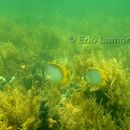Diagnostic Description
provided by Fishbase
Body is white with a black bar running across the head through the eye. In juveniles, a second black bar runs from the base of the soft portion of the dorsal fin to the base of the anal fin. The dorsal, caudal and anal fins are either yellow or transparent (Ref. 4855). A narrow yellow bar from gill opening to pectoral base (Ref. 13442).
Diseases and Parasites
provided by Fishbase
Hurleytrematoides Infestation 3. Parasitic infestations (protozoa, worms, etc.)
Diseases and Parasites
provided by Fishbase
Hurleytrematoides Infestation 8. Parasitic infestations (protozoa, worms, etc.)
Life Cycle
provided by Fishbase
Form pairs during breeding (Ref. 205).
Morphology
provided by Fishbase
Dorsal spines (total): 12 - 14; Dorsal soft rays (total): 18 - 21; Analspines: 3; Analsoft rays: 15 - 17
Trophic Strategy
provided by Fishbase
Inhabit shallow, coral reefs with clear water (Ref. 9626, 57616). Develop dusky bands at night. Generally common (Ref. 9710). Browser (Ref. 33499).
Pitts, P.A. 1991 Comparative use of food and space by three Bahamian butterflyfishes. Bull. Mar. Sci. 48(3):749-756.
Biology
provided by Fishbase
Inhabit shallow, coral reefs with clear water (Ref. 9626). Develop dusky bands at night. Generally common (Ref. 9710). Oviparous (Ref. 205). Form pairs during breeding (Ref. 205).
Importance
provided by Fishbase
aquarium: commercial
Spotfin butterflyfish
provided by wikipedia EN
The spotfin butterflyfish (Chaetodon ocellatus) is species of marine ray-finned fish, a butterflyfish from the family Chaetodontidae. It is found in the western Atlantic Ocean, in the Gulf of Mexico and most commonly found in the Caribbean Sea.
The name is derived from the dark spot on the fish's dorsal fin. This, combined with a vertical, black bar through the eye, is an adaptation that can confuse predators. The vertical black bar disappears as the fish gets older and other black lines become more prominent. Along with other Caribbean Seas reef dwelling tropical fish, many young spotfin butterfly fish get sucked up the gulf stream from July to late October and are dumped into Long Island bays.[3] The spotfin butterfly fish is very common and very hard to maintain in a tank. The spotfin butterfly fish can grow up to 6–8 inches.
References

- license
- cc-by-sa-3.0
- copyright
- Wikipedia authors and editors
Spotfin butterflyfish: Brief Summary
provided by wikipedia EN
The spotfin butterflyfish (Chaetodon ocellatus) is species of marine ray-finned fish, a butterflyfish from the family Chaetodontidae. It is found in the western Atlantic Ocean, in the Gulf of Mexico and most commonly found in the Caribbean Sea.
The name is derived from the dark spot on the fish's dorsal fin. This, combined with a vertical, black bar through the eye, is an adaptation that can confuse predators. The vertical black bar disappears as the fish gets older and other black lines become more prominent. Along with other Caribbean Seas reef dwelling tropical fish, many young spotfin butterfly fish get sucked up the gulf stream from July to late October and are dumped into Long Island bays. The spotfin butterfly fish is very common and very hard to maintain in a tank. The spotfin butterfly fish can grow up to 6–8 inches.
- license
- cc-by-sa-3.0
- copyright
- Wikipedia authors and editors
Diet
provided by World Register of Marine Species
Feeds on coral polyps, other invertebrates and ectoparasites
North-West Atlantic Ocean species (NWARMS)
- license
- cc-by-4.0
- copyright
- WoRMS Editorial Board
Distribution
provided by World Register of Marine Species
Western Atlantic: 43.35°N to Florida, USA to Brazil; also Bahamas, Gulf of Mexico and Caribbean, including Antilles
North-West Atlantic Ocean species (NWARMS)
- license
- cc-by-4.0
- copyright
- WoRMS Editorial Board
Habitat
provided by World Register of Marine Species
nektonic
North-West Atlantic Ocean species (NWARMS)
- license
- cc-by-4.0
- copyright
- WoRMS Editorial Board
Habitat
provided by World Register of Marine Species
Inhabits shallow, coral reefs with clear water.
North-West Atlantic Ocean species (NWARMS)
- license
- cc-by-4.0
- copyright
- WoRMS Editorial Board

